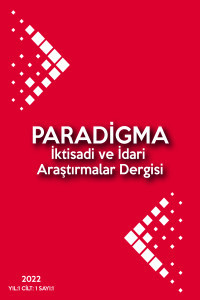KURUMSAL DEĞİŞKENLERİN ULUSLARARASI DOĞRUDAN YATIRIMLAR ÜZERİNDEKİ ETKİSİ: ÜST-ORTA GELİR GRUBU ÜLKELER ÖRNEĞİ
Geçen yirmi yılda uluslararası ticaretin tüm dünyada demokrasiyi teşvik eder hale gelmesi ve artan ekonomik globalizasyonun sonucu olarak, kurumlar ve doğrudan yabancı yatırımlar (DYY) arasındaki ilişki, giderek artan bir ilgi görmüştür. Bu çalışmada, sosyo ekonomik ve politik kurumsal değişkenlerin doğrudan yabancı yatırımlara olan etkisini 54 üst-orta gelir grubundaki gelişmekte olan ülke için panel data regresyon tekniğini kullanarak 1995-2011 dönemi için analiz etmekteyiz. Ampirik bulgulara göre kurumsal değişkenler DYY üzerine anlamlı etkiye sahiptirler ancak makroekonomik değişkenlerin DYY üzerine etkisi kurumsal değişkenlerden daha güçlüdür. Özellikle, piyasa hacmi göstergesi olan değişkenler, nüfusun artış hızı, global rekabet edebilirlik ve uluslararası ülke riski DYY’nin ülkeye girişinde önemli rol oynamaktadır.
Anahtar Kelimeler:
Kurumsal Değişkenler, Doğrudan Yabancı Yatırımlar, Üst-Orta Gelir Grubu Ülkeleri, Panel Data Regresyon
THE EFFECT OF INSTITUTIONAL VARIABLES ON FDI INFLOWS: EVIDENCE FROM UPPER-MIDDLE INCOME COUNTRIES
For two decades, the relationship between institutions and foreign direct investment (FDI) is receiving a growing attention as a result of increasing economic globalization and international trade promoting democracy all over the world. In this paper, we investigate the impact of institutional variables, social, economic and political, on foreign direct investment inflows into 54 upper-middle income developing countries applying panel data regressions for the period 1995-2011. The findings suggest that the institutional variables have significant effect on FDI inflows but their impact is weaker than macoreconomic variables. Especially, the market size indicators, population growth rate, global competitiveness and international country risk play a major role in attracting FDI.
Keywords:
Institutional Variables, Foreign Direct Investment, Upper-Middle Income Countries, Panel Data Analaysis,
___
- Acemoglu, D., S. Johnson, and J. Robinson. (2004). Institutions as the Fundamental Cause of Long-Run Growth in P. Aghion and S. Durlauf (eds). Handbook of Economic Growth. Amsterdam: North Holland. Acemoglu, D., and Johnson, S. (2005). Unbundling Institutions. Journal of Political Economy. 949-95. Ali, S., and Guo, W. (2005). Determinants of FDI in China. Journal of Global Business and Technology. V.1 (2). 21-33. Altomonte, C. (2000). Economic Determinants and Institutional Frameworks: FDI in Economies in Transition. In U. N. Development (Ed.). 9. pp. 75-106. Asiedu, E. (2006). Foreign Direct Investment in Africa: The Role of Natural Resources, Market Size, Government Policy. Institutions and Political Instability. United Nations University. 63-77. Baltagi, B. H. (2005). Econometric Analysis of Panel Data (third edition b.). USA. John Wiley. Bénassy-Quéré, A., Coupet, M. and Mayer, T. (2007). Institutional Determinants of Foreign Direct Investment. The World Economy. Bevan, A., Estrin, S. and Meyer, K. (2004). Foreign Investment Location and Institutional Development In Transition Economies. International Business Review. V.13. 43-64. Borenszteina, E., Gregoriob, J. D., and Lee, J.-W. (1998). How Does Foreign Direct Investment Affect Economic Growth. Journal of International Economics. 45, 115-135. Buckley, P. J. (2007). The Determinants of Chinese Outward Foreign Direct Investment. Journal of International Business Studies. 38 (4). pp. 499-518. Coyne, C. J., and Sobel, R. S. (2010). How Are Institutions Related. Economic Freedom of the World 2010 Annual Report. Clarke, G.R.G. (2001). How The Quality of Institutions Affects Technological Deepening in Developing Countries. Policy Research Working Paper Series 2603. World Bank, Washington DC. Daniele, V. and Marani, U. (2006). Do Institutions Matter For FDI? A Comparative Analysis of The MENA Countries. MPRA Paper No. 2426. Dumludağ, D. (2006). Political Institutions and Foreign Direct Investment Flows into Developing Countries. Eviews (2006). Eviews 5.1 Help. Reviews. Gwartney, J., Lawson, R., and Hall, J. (2011). Economic Freedom of the World 2011 Annual Report. Fraser Institute. Hisarciklilar, M., Kayam, S. S., and Kayalica, M. (2007). Locational Drivers of FDI in MENA Countries: A Spatial Attempt. MPRA Paper . J.Barro, R. (1996). Democracy and Growth. Journal of Economic Growth (1), 1-27. Janine, A. (2000). Growth and Institutions A Review of the Evidence. World Bank Research Observer. 15 (199-135). Kayam, S. S. (2006). Home Market Determinants of FDI Outflows from Developing and Transition Economies. Economic and Social Research Center (ESRC). 1-19. Kauffman, D. and Kraay, A. (2008). Governance Indicators: Where Are We, Where Should We Be Going? The World Bank Research Observer, 23 (1), 1 – 30 Koyuncu, J. Y. (2010). Yargı Bağımsızlığı Mülkiyet Hakkı ve Yolsuzluğun Yabancı Sermaye Girişleri Üzerindeki Etkisi. Dumlupınar SBE Dergisi. 143-148. Knack, S. and Keefer, P. (1995). Institutions And Economic Performance: Crosscountry Tests Using Alternative Institutional Measures. Economics and Politics. 7. 207-227. Kostevc, et.al. (2007). Foreign Direct Investment and Institutional Environment in Transition Economies. Transition Studies Review. 14 (1). 40-54. LI, X. (2005). Foreign Direct Investment and Economic Growth: An Increasingly Endogenous Relationship. Worm Development. 33 (3). 393-407. Masron, T. A., and Abdullah, H. (2010). Institutional Quality as A Determinant for Fdi Inflows: Evidence From Asean. World Journal of Management. North, D. C. (1991). Institutions. Journal of Economic Perspectives. 5 (1). 97-112. North, D. C. (1990). Institutions, Institutional Cahnge and Economic Performance. New York: Cambridge University Press. Obwona, M. B. (1997). Determinants of FDI and Their Impact on Economic. Economic Policy Research Centre. Rodrik, D., and Subramania, A. (2003, June). The Primacy of Institutions. Finance and Development. 30-34. Sadıq, A. A. (2009). The Effects of Corruption on FDI Inflows. Cato Journal. 29 (2). 267-288. UNCTAD (2011). The World Investment Report 2011. New York: UN. Wafure, O. G. and Nurudeen, A. (2010). Determinants of Foreign Direct Investment in Nigeria: An Empirical Analysis. Global Journal of Human Social Science. 26-34. Xu, D., and Shenkar, O. (2002). Institutional Distance and the Multinational Enterprise. The Academy of Management Review. 27 (4). 608-618.
- Yayın Aralığı: Yılda 2 Sayı
- Yayıncı: Gümüşhane Üniversitesi
Sayıdaki Diğer Makaleler
Murat KARAÖZ, Murat Ali DULUPÇU, Mesut ALBENİ, Hakan DEMİRGİL, Onur SUNGUR
An Investigation on the Effect of Defense Expenditure on Economy in Turkey
Book Review Cultural Variations and Business Performance Contemporary Globalism
Ahmet Mutlu AKYÜZ, Hasan AYYILDIZ
